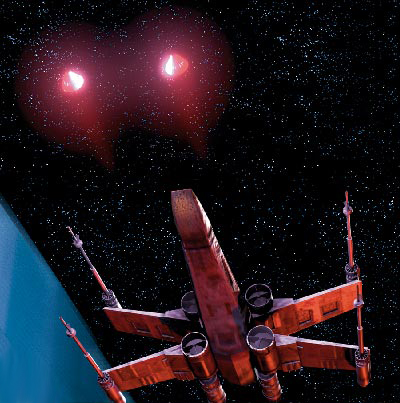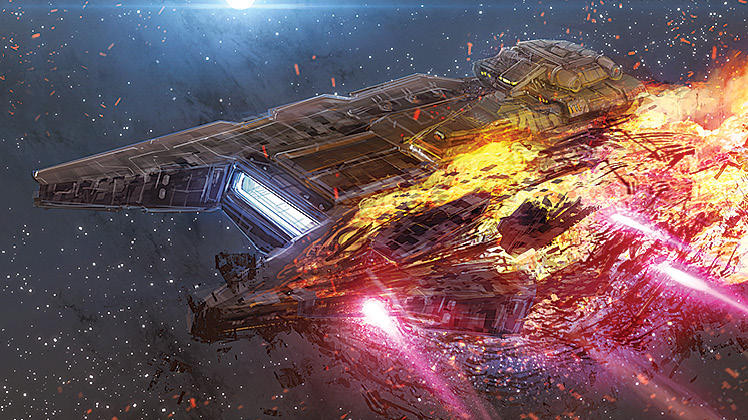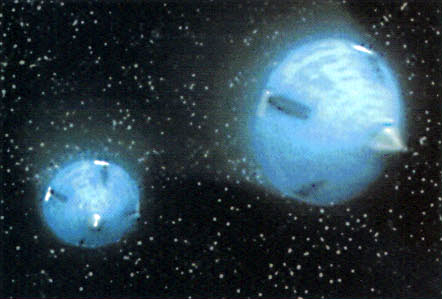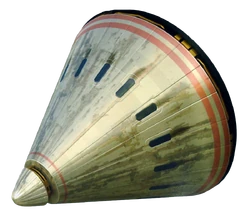A widely utilized type of focused nuclear explosive throughout the galaxy was the proton torpedo. The Battle of Yavin saw its most memorable employment, where Luke Skywalker annihilated the first Death Star by precisely delivering a pair of proton torpedoes into a thermal exhaust port. Certain advanced versions were equipped with the capability to lock onto targets, with some being more sophisticated than others.

Proton torpedoes were essentially impact-based projectiles that carried significant proton-scattering energy warheads designed for high-yield explosions. Considered among the most potent armaments a starfighter could deploy, these torpedoes detonated upon impact, releasing substantial explosive force.
Because a single fighter could only carry a relatively small number of proton torpedoes, their usefulness was somewhat limited. As a result, they typically served as supplementary weapons, enhancing the primary firepower of the craft, which usually consisted of laser cannons. Starfighters such as the Rebel Alliance's X-wing and Y-wing often had laser based weaponry paired with launchers for firing proton torpedoes.
Being physical, kinetic weapons, proton torpedoes were immune to a target's ray shields. The destructive potential of a single proton warhead was sufficient to obliterate a starfighter and inflict considerable damage on capital ships by directly impacting the target's hull or particle shields.
The onboard guidance computers enabled the proton torpedo to precisely target its objective. While the computer had a three meter margin of error, a sufficiently swift and maneuverable craft could evade a pursuing torpedo. Certain pilots opted to launch torpedoes without activating their homing computers, due to the risk of a missed torpedo acquiring a new target, potentially including allied vessels. Each torpedo was encased in a protective energy field, designed to prevent accidental detonation from debris impact or laser fire.
These torpedoes possessed exceptional maneuverability, capable of executing a ninety-degree turn within a meter's turning radius, allowing their use against starfighters. An example of this is when Corran Horn, piloting his X-wing, employed them against Erisi Dlarit's TIE Interceptor.
Coordinated, massed volleys of proton torpedoes from fighters could inflict substantial damage to capital ships, provided the launches were timed for near-simultaneous impact.

During the Battle of Naboo, proton torpedoes saw action by N-1 starfighter pilots. After Anakin Skywalker made an emergency landing within the Droid Control Ship, he reactivated his fighter, defending himself with laser cannons against Trade Federation battle droids. Inadvertently, he destroyed the control ship by accidentally launching two proton torpedoes into its starboard pilot reactor.
During the Rebel assault on the first Death Star, Alliance fighters were compelled to use high-speed proton torpedoes against the thermal exhaust port, the Death Star's only vulnerable point. Standard laser weapons proved ineffective, as the port was protected by ray shields.

Wedge Antilles employed proton torpedoes against the second Death Star's power regulator.
In 19 ABY, Imperial Remnant Admiral Gilad Pellaeon's flagship, the Chimaera, faced an attack from pirates in disguise, hired by Moff Vilim Disra and falsely claiming to be sent by New Republic General Garm Bel Iblis. Pellaeon countered by deploying a squadron of his SoroSuub Preybird fighters to conceal the launch of a proton torpedo salvo from the Chimaera, which swiftly annihilated the attacking fleet. This action also convinced Pellaeon that Bel Iblis was not behind the attack, as the maneuver was a variation of the A-wing Slash, a tactic Bel Iblis himself had pioneered in 9 ABY.
Proton torpedoes were known as "boomers" by Commenorian pilots.
In the Star Wars radio drama, they used the term photon torpedoes, which originates from Star Trek.
In the X-Wing series of computer games, proton torpedoes were designed for use against most targets except snubfighters, because they moved slower than concussion missiles but inflicted more damage. However, this is inconsistent with information from many Legends sources, which depict both proton torpedoes and concussion missiles as general weapon types with varying yields. Therefore, this should be considered a simple game mechanic.
In Star Wars: TIE Fighter, the proton torpedo is shown as a short, blue missile on the hangar screen where players can change their loadout. This contradicts established canon, which depicts the torpedo as cone-shaped, although this might be due to a different manufacturer than those used by the Rebel Alliance.
According to the Star Wars Sourcebook: A New Hope for the roleplaying game, proton torpedoes caused slightly more damage than concussion missiles and were cheaper per warhead. However, complete particle shielding could effectively deflect them.
Although Jedi Trial claims that proton torpedoes were a new weapon introduced during the Clone Wars, the N-1 starfighter used them during the Battle of Naboo. In addition, in Star Wars: Knights of the Old Republic II: The Sith Lords, Atton Rand mentions proton torpedoes, suggesting they may have existed long before the conflict. Also, if you play the game's prologue, you can find a proton torpedo stuck in the hull of the Ebon Hawk with its explosive charge intact, which can be used as an explosive. This is also a rare instance of a proton torpedo not exploding on impact.
In Star Wars: Battlefront II, TIE fighters had proton torpedoes to balance the two sides.
The exact composition of proton torpedo warheads remains unclear, as few sources detail their actual nature. However, in the Star Wars: Legacy of the Force series, two different authors stated that they use a baradium main charge, detonated by a proton detonator. Some sources say that the blast is focused into a narrow cone to maximize effectiveness and minimize collateral damage and energy leakage. However, most sources, especially those describing the effects of a hit on a starfighter, show these weapons producing a more uniform explosion. This is evident when Wedge Antilles destroyed a concrete tube with one: the torpedo passed through the tube and detonated ten meters away, yet the resulting fireball engulfed the tube. This could mean that proton torpedoes can vary their blast shape, or that Rogue Squadron used a general-purpose torpedo while shaped-blast torpedoes are a specialized model.
A shaped-blast nuclear warhead, similar to some descriptions of the proton torpedo in Legends, is a real-world proposed weapon. The U.S. military Project Casaba Howitzer, which is still partially classified, details this technology.
